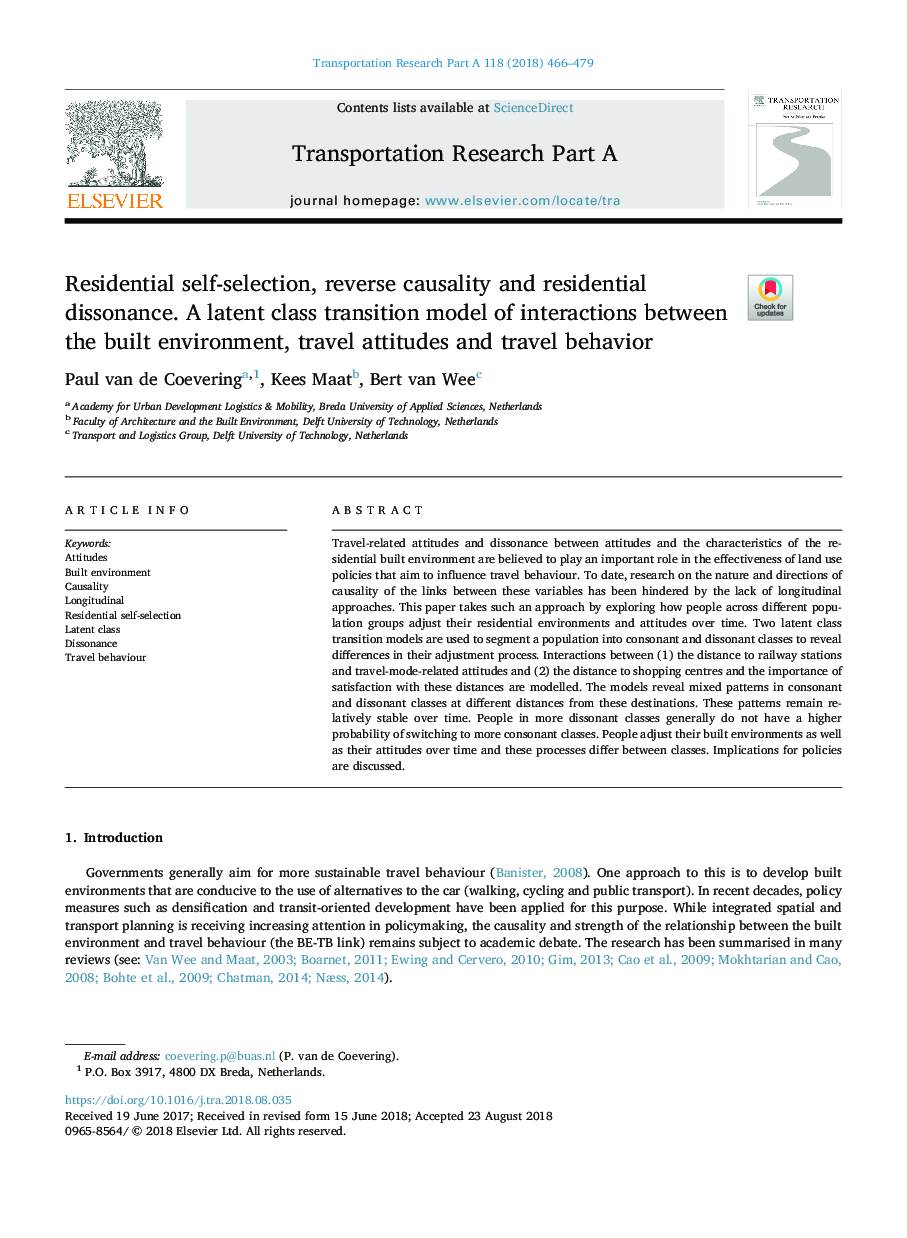| کد مقاله | کد نشریه | سال انتشار | مقاله انگلیسی | نسخه تمام متن |
|---|---|---|---|---|
| 11030179 | 1646370 | 2018 | 14 صفحه PDF | دانلود رایگان |
عنوان انگلیسی مقاله ISI
Residential self-selection, reverse causality and residential dissonance. A latent class transition model of interactions between the built environment, travel attitudes and travel behavior
ترجمه فارسی عنوان
خود انتخاب انتخابی مسکونی، علیت معکوس و اختلال مسکونی. یک مدل انتقال پنهان کلاس تعامل بین محیط ساخته شده، نگرش های سفر و رفتار سفر
دانلود مقاله + سفارش ترجمه
دانلود مقاله ISI انگلیسی
رایگان برای ایرانیان
کلمات کلیدی
نگرش های، محیط ساخته شده، علیت، طولی خود انتخابی مسکونی، کلاس خاموش ناشناخته، رفتار مسافرت،
ترجمه چکیده
اعتقاد بر این نگرش های مربوط به مسافرت و ناهماهنگی بین نگرش ها و خصوصیات محیط زیست مسکونی نقش مهمی در اثربخشی سیاست های استفاده از زمین دارند که هدف آن تأثیر رفتار مسافرت است. تا به امروز، تحقیق در خصوص ماهیت و جهت گیری علیت ارتباطات بین این متغیرها با فقدان رویکرد های طولی مواجه شده است. این مقاله با بررسی این موضوع که چگونه مردم در میان گروه های مختلف جمعیت، محیط زندگی و نگرش خود را در طول زمان تنظیم می کنند، چنین رویکردی را دنبال می کند. دو مدل انتقال پنهان کلاس به منظور تقسیم جمعیت به کلاس های مخلوط و مخلوط برای نشان دادن تفاوت در روند سازگاری آنها استفاده می شود. تعاملات بین (1) فاصله تا ایستگاه های راه آهن و نگرش های مربوط به حالت سفر و (2) فاصله تا مراکز خرید و اهمیت رضایت از این فاصله ها مدل سازی می شوند. این مدل ها الگوهای مخلوطی را در کلاس های مخلوط و ناسازگار در فاصله های مختلف از این مقصد ها نشان می دهند. این الگوها در طول زمان نسبتا پایدار باقی می مانند. افرادی که در کلاس های غیرمنتظره بیشتر هستند، احتمال بیشتری برای تغییر کلاس های همسانی ندارند. مردم محیط های ساخته شده و همچنین نگرش آنها را در طول زمان تنظیم می کنند و این فرآیندها بین کلاس ها متفاوت است. پیامدهای سیاست ها مورد بحث قرار می گیرد.
موضوعات مرتبط
مهندسی و علوم پایه
سایر رشته های مهندسی
مهندسی عمران و سازه
چکیده انگلیسی
Travel-related attitudes and dissonance between attitudes and the characteristics of the residential built environment are believed to play an important role in the effectiveness of land use policies that aim to influence travel behaviour. To date, research on the nature and directions of causality of the links between these variables has been hindered by the lack of longitudinal approaches. This paper takes such an approach by exploring how people across different population groups adjust their residential environments and attitudes over time. Two latent class transition models are used to segment a population into consonant and dissonant classes to reveal differences in their adjustment process. Interactions between (1) the distance to railway stations and travel-mode-related attitudes and (2) the distance to shopping centres and the importance of satisfaction with these distances are modelled. The models reveal mixed patterns in consonant and dissonant classes at different distances from these destinations. These patterns remain relatively stable over time. People in more dissonant classes generally do not have a higher probability of switching to more consonant classes. People adjust their built environments as well as their attitudes over time and these processes differ between classes. Implications for policies are discussed.
ناشر
Database: Elsevier - ScienceDirect (ساینس دایرکت)
Journal: Transportation Research Part A: Policy and Practice - Volume 118, December 2018, Pages 466-479
Journal: Transportation Research Part A: Policy and Practice - Volume 118, December 2018, Pages 466-479
نویسندگان
Paul van de Coevering, Kees Maat, Bert van Wee,
